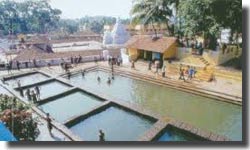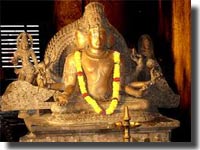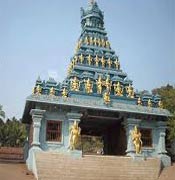Location :
Temple of Manjunatheshwara which is on the hills of Kadri is a very beautiful and popular temple in Mangalore. It has been built during the 10th or 11th century. Later it was converted into a complete stone structure during the 14th century. The idol of Lord Manjunathaswamy of the temple is called as the oldest of the South Indian Temples.
Significance of the temple
The legend here is believed that Parashurama who was then living in Sahyadri, killed the kshathriyas who were very much cruel and donated the lands to Kashyapa. He prayed to Lord Shiva for a place to live. Lord Shiva had assured Parashurama that if he performed a penance at Kadali kshethra, Lord Shiva would reincarnate as the Manjunatha for the betterment of the world.
According to Lord Shiva's orders Parashurama threw his axe into the sea and created a place for his penance. Yielding to Parashurama's prayers Lord Shiva appeared to him as Manjunatha along with Goddess Parvathi and stayed at Kadri for the betterment of the world. As according to the orders of Manjunatha the sapthakoti manthras become the seven theerthas.
In front of the temple at a height there are a number of water ponds. Then there's a garden surrounding the ponds. When one walks down from there in front of the temple there is a huge lightpole. During Karthika Maasa (month) a deepothsava is held here. There are statues of Machendranath, Gorakanath, Shringinath, Lokeshwara, Manjushri and Budha in the temple.
The Padmasanastha Lokeshwara statue is very beautiful. Behind the temple of Manjunatha upto the west is the temple of Goddess Durga. To the Northern side is the temple of Lord Ganesha.

The Lord Kadri Manjunatha Temple is one of the famous and ancient temples located on Kadri hills in Mangalore city. It is believed that the temple has been built during the 10th century and it was converted to a complete stone structure during the 14th century. The Kadri Manjunatha temple was built with nine water tanks nestling at the foot of the highest hill at Kadri in Mangalore. This Temple on Kadri hills is dedicated to Lord Manjunatha, an incarnation of Lord Shiva. The idol of Lord Manjunatha is the oldest among the south Indian temples. The idol of Lord Manjunatha is made of bronze. The sub-deities in the temple here include Lord Ganesh, Lord Vishnu, Goddess Durgaparmeshwari, Lord Shasta, Vyasa Muni and Gomukha Ganpathi.
The main unique attraction of Kadri are the temples, the seven sacred ponds, Jogi Mutt and caves of Pandavas.

Lord Shiva was pleased from Parashurama's penance and Lord had appeared to him as Manjunatha along with his wife Goddess Parvathi and resided at Kadri for the welfare of the world. Yielding to the Parashurama's prayers Lord Shiva appeared to him as Manjunatha along with Goddess Parvathi and stayed at Kadri for the betterment of the world. According to the instructions of Lord Manjunatha, the Sapthakoti manthras become the seven sacred ponds. In front of the temple, at a height there are 7 water ponds. There's a garden surrounding the ponds. There is a natural spring at an important location on the backside of the temple. It is called as Gomukha. The water from this spring is let into 7 ponds and devotees before entering the temple come here and wash themselves. Festivals like Lakshadeepotsava and Pattanaje are the main festivals celebrated here in a great devotion.

An interesting feature of this a natural stone slab found parallel to the level of the floor of the 'garbha griha' is that whatever amount of water poured on it will be disappear immediately. The temple also houses a 1.6m tall bronze statue of the main deity Lokeshwara in a seated position with three faces and six arms which is reputed to be one of the best bronze statues in India. Apart from the main deity, Durgaparmeshwari, Ganapathi, Shasta and Gomukha Vyasa Muni and Vishnu are the sub deities worshipped here.
The temple complex contains seven water tanks surrounded by a beautiful garden. These ponds receive water from a natural spring known as Gomukha that flows the backside of the temple.
Accommodation near the Mosque
 |
Nearby tourist places to Kadri Manjunath Temple
Bangalore Iddukki Malpe beach Mangalore |
The temple has also figures of Matsyendranatha with his palms held one over the other on his folded right leg which is located on southern side; a six feet high structure of Gorakhanath on the western side and the figure of Sringinatha, which is ornamented with three tiers in the midst. A tall wooden 'Deepa Sthamba' (light pole) covered with bronze adorns the temple. Goddess Durga temple is situated to the west of main temple while a temple of Lord Ganesha is at the northern side |
Transport Facilities at the Temple
- For tourists the closest airport is at Gaggal which is around 50 km away
- The nearest railhead is a narrow gauge one at Ranital, 20 km away. The Chandigarh airport and railway station are at the distance of about around 200 km. Trains from Pathankot to Joginder Nagar leave at 2.15 h, 4.50 h, 8.50 h, 9.35 h, 13.10 h, 16.00 h and reach Jwalamukhi road in 3 h and from there by bus to visit Jwalaji.
- The Jwalamukhi temple is also well connected by road. State transport buses from cities of Punjab and Haryana are available.
- Taxis are also there to take you to the Jwalamukhi temple. Frequent buses pass through Kangra, distance 54 km and takes 2 hour. Kangra is 36 km away from Jwalamukhi. Buses are also coming from Pathankot (123 km), Mandi (171 km), Manali (281 km). Simla (321 km), Palampur, Joginder Nagar and from several places of North India.



